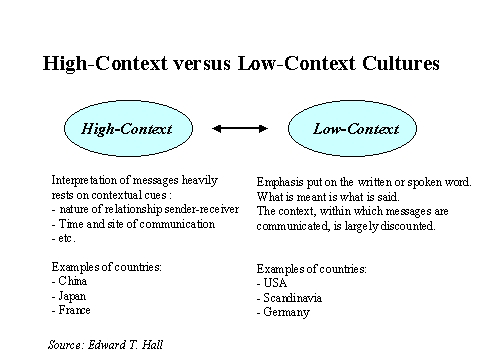1. Edward T. Hall: The Theory of High & Low Context Cultures
We mentioned Hall in our discussion of non verbal communication, as the anthropologist who coined the term 'proxemics': the study of how people use space. He has written a number of books about both non verbal communication and culture, including The Silent Language (1959 & 1990), The Hidden Dimension (1969) and Beyond Culture (1976). Hall argued that cultural differences could be better understood if they were divided into two groups: high context and low context. A key factor in his theory is context. This relates to the framework, background, and surrounding circumstances in which communication or an event takes place. Here's some more information.
The following summary highlights the problems facing low-context North Americans when they interact with people from high-context cultures.
|
 |
2. Geert Hofstede:
Dr. Geert Hofstede conducted perhaps the most comprehensive study of how values in the workplace are influenced by culture. From 1967 to 1973, while working at IBM as a psychologist, he collected and analyzed data from over 100,000 individuals from forty countries. From those results, and later additions, Hofstede developed a model that identified four primary dimensions with which to analyse and differentiate cultures. He later added a fifth dimension. These dimensions work on a continuum which measures the degree to which different cultures exhibit these characteristics. They are:
a. Power distance index (PDI)
b. Individualism (IDV)
c. Masculinity (MAS)
d. Uncertainty Avoidance Index (UAI)
e. Long Term Orientation (LTO)
Hofstede's research has been used widely in business as a training aid in understanding international cultural relationships. For more detail on the dimensions, check out Hofstede's site and his explanation of how the dimensions work.
To see how the orientation rankings are applied to different countries, check out this link. For a critique of Hofstede's research, read this journal article.
Ray's textbook Communicating As Professionals (2007) also has a good chapter on Intercultural Communication (chapter 4, p.87). In particular check out exhibit 4.2 on p.101 for an overview of Hofestede's dimensions and how they apply when you compare aspects of behaviour in Australia and other cultures.